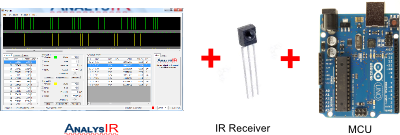Here are some photos we captured, of a sample of our MCU test rigs and custom PCB for AnalysIR.

The photo above shows some of our test setup for Arduino, Raspberry Pi, TI MSP430 LaunchPad and the (big) baby of them all the USB IR Toy. The small red custom PCBs are ones we had made via Elecrow which worked out great. So instead of just using solderless breadboards we now plug these ‘half shields’ directly into the Arduino header, or in the case of the RPi using a ribbon cable. The USB IR Toy already has the IR receivers on board and doesn’t require this PCB.
We should also be able to hook up the LaunchPad to this board using headers. So once we receive the full set of headers, we ordered on-line, we will have all our test setups much neater and more reliable. Previously, we used solderless breadboards, as can be seen in the photo attached to the LaunchPad. Continue reading Testing AnalysIR with a custom PCB




